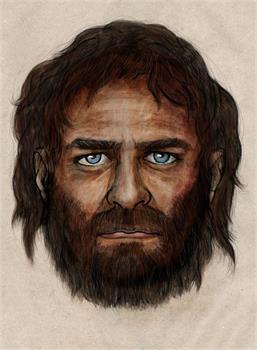 |
Blue-Eyed Hunter-Gatherers Roamed Prehistoric Europe, Gene Map Reveals
 |
Mapping the blue-eyed boy's genes is part of ongoing effort to uncover the DNA of ancient humans. The new study in the journal Nature, led by Inigo Olalde of Spain's Institut de Biología Evolutiva in Barcelona, reports the genetic map of a skeleton found in a Spanish cave. (See also: "Modern Europe's Genetic History Starts in Stone Age.")
Why It Matters
Scholars had suspected that blue eyes arrived as an import into Europe, brought by late-arriving farmers who invaded the continent more than 5,000 years ago. Contrary to the conventional picture of a blue-eyed, fair-haired northern European, the study suggests that blue eyes were already common among the continent's early hunter-gatherers, along with darker skin.
But those aren't the only results that matter from the study. The researchers also discovered that a number of disease-resistance genes seen in modern Europeans were active in the ancient Spaniard's gene map. And the study adds genetic support to archaeological findings that hint that a widespread hunter-gatherer culture cut continuously across Europe in prehistory.
What They Did
The researchers extracted DNA from a tooth found with the skeleton of man, dubbed La Brana 1, uncovered in a cave near León, Spain, in 2006.
In the lab, they compared the DNA from the man with DNA from other Stone Age Europeans, such as Ötzi, the 5,300-year-old "Iceman" of the Alps (whose people were farmers), and older, partial samples of genes recovered from hunter-gatherer burials in Sweden, Finland, and Siberia.
They also compared the results against the DNA of 35 modern-day Europeans.
What They Found
Around 7,000 years ago, a Stone Age culture spread across Europe, made famous by discoveries of small, rotund "Venus" figurines found in their burials. The study results suggest those people were genetically connected—one thin population of dark-haired hunter-gatherers whose domain reached from Spain to Siberia. They were also partly the ancestors of many of today's northern Europeans.
Moreover, the ancient Spaniard had multiple genes linked to disease immunity, resistance to bacteria, and risks for musculoskeletal ailments, ones seen in people today. Understanding the origin of these genes can help better explain their function, which could aid medical studies, for example.
For fans of the "Paleo Diet" and other get-back-to-nature notions, the study brings some good news, suggesting that people carry around plenty of genes left over from their primeval forebears. The survival of some disease-resistance genes that mattered greatly in antiquity, as shown by their continuity in modern humans, also can help show how evolution worked its magic on us, and is still working today.
National Geographic
1005 page views
|
|
|
|